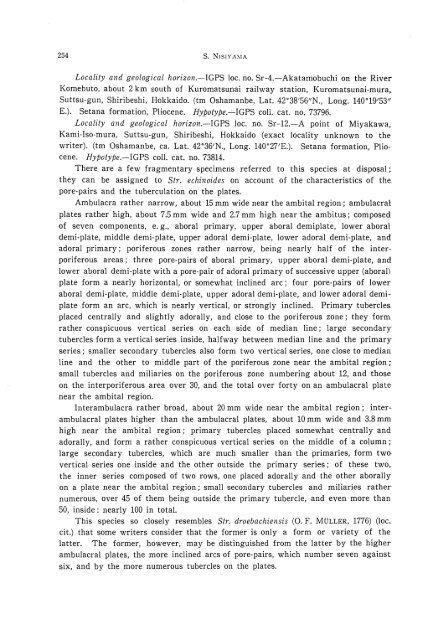the echinoid fauna from japan and adjacent regions part i
the echinoid fauna from japan and adjacent regions part i
the echinoid fauna from japan and adjacent regions part i
Create successful ePaper yourself
Turn your PDF publications into a flip-book with our unique Google optimized e-Paper software.
254 s. NISIY A:\IA<br />
Locality <strong>and</strong> geological horizon.-IGPS loco no. Sr-4.-Akatamobuchi on <strong>the</strong> River<br />
Komebuto, about 2 km south of Kuromatsunai railway station, Kuromatsunai-mura.<br />
Suttsu-gun, Shiribeshi, Hokkaido. (tm Oshamanbe, Lat. 42°38'56/1N., Long. 140°19'53/1<br />
E.). Set ana formation, Pliocene. Hypotype.-'-IGPS colI. cat. no. 73796.<br />
Locality <strong>and</strong> geological horizon.-IGPS loco no. Sr-12.-A point of Miyakawa,.<br />
Kami-Iso-mura, Suttsu-gun, Shiribeshi, Hokkaido (exact locality unknown to <strong>the</strong><br />
writer). (tm Oshamanbe, ca. Lat. 42°36'N., Long. 140 0 27'E.). Setana formation, Pliocene.<br />
Hypotype.-IGPS colI. cat. no. 73814.<br />
There are a few fragmentary specimens referred to this species at disposal;<br />
<strong>the</strong>y can be assigned to Str. <strong>echinoid</strong>es on account of <strong>the</strong> characteristics of <strong>the</strong><br />
pore-pairs <strong>and</strong> <strong>the</strong> tuberculation on <strong>the</strong> plates.<br />
Ambulacra ra<strong>the</strong>r narrow, about 15 mm wide near <strong>the</strong> ambital region; ambulacral<br />
plates ra<strong>the</strong>r high, about 7.5 mm wide <strong>and</strong> 2.7 mm high near <strong>the</strong> ambitus; composed<br />
of seven components, e. g., aboral primary, upper aboral demiplate, lower aboral<br />
demi-plate, middle demi-plate, upper adoral demi-plate, lower adoral demi-plate, <strong>and</strong><br />
adoral primary; poriferous zones ra<strong>the</strong>r narrow, being nearly half of <strong>the</strong> interporiferous<br />
areas; three pore-pairs of aboral primary, upper aboral demi-plate, <strong>and</strong><br />
lower aboral demi-plate with a pore-pair of adoral primary of successive upper (aboraD<br />
plate form a nearly horizontal, or somewhat inclined arc; four pore-pairs of lower<br />
aboral demi-plate, middle demi-plate, upper adoral demi-plate, <strong>and</strong> lower adoral demiplate<br />
form an arc, which is nearly vertical, or strongly inclined. Primary tubercles<br />
placed centrally <strong>and</strong> slightly adorally, <strong>and</strong> close to <strong>the</strong> poriferous zone; <strong>the</strong>y form<br />
ra<strong>the</strong>r conspicuous vertical series on each side of median line; large secondary<br />
tubercles form a vertical series inside, halfway between median line <strong>and</strong> <strong>the</strong> primary<br />
series; smaller secondary tubercles also form two vertical series, one close to median<br />
line <strong>and</strong> <strong>the</strong> o<strong>the</strong>r to middle <strong>part</strong> of <strong>the</strong> poriferous zone near <strong>the</strong> ambital region;<br />
small tubercles <strong>and</strong> miliaries on <strong>the</strong> poriferous zone numbering about 12, <strong>and</strong> those<br />
on <strong>the</strong> interporiferous area over 30, <strong>and</strong> <strong>the</strong> total over forty on an ambulacral plate<br />
near <strong>the</strong> ambital region.<br />
Interambulacra ra<strong>the</strong>r broad, about 20 mm wide near <strong>the</strong> ambital region; interambulacral<br />
plates higher than <strong>the</strong> ambulacral plates, about 10 mm wide <strong>and</strong> 3.8 mm<br />
high near <strong>the</strong> ambital region; primary tubercles placed somewhat centrally <strong>and</strong><br />
adorally, <strong>and</strong> form a ra<strong>the</strong>r conspicuous vertical series on <strong>the</strong> middle of a column;<br />
large secondary tubercles, which are much smaller than <strong>the</strong> primaries, form two<br />
vertical series one inside <strong>and</strong> <strong>the</strong> o<strong>the</strong>r outside <strong>the</strong> primary series; of <strong>the</strong>se two,<br />
<strong>the</strong> inner series composed of two rows, one placed adorally <strong>and</strong> <strong>the</strong> o<strong>the</strong>r aborally<br />
on a plate near <strong>the</strong> ambital region; small secondary tubercles <strong>and</strong> miliaries ra<strong>the</strong>r<br />
numerous, over 45 of <strong>the</strong>m being outside <strong>the</strong> primary tubercle, <strong>and</strong> even more than<br />
50, inside: nearly 100 in total.<br />
This species so closely resembles Str. droebachiensis (0. F. MULLER, 1776) (loc.<br />
cit.) that some writers consider that <strong>the</strong> former is only a form or variety of <strong>the</strong><br />
latter. The former, however, may be distinguished <strong>from</strong> <strong>the</strong> latter by <strong>the</strong> higher<br />
ambulacral plates, <strong>the</strong> more inclined arcs of pore-pairs, which number seven against<br />
six, <strong>and</strong> by <strong>the</strong> more numerous tubercles on <strong>the</strong> plates.












